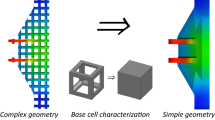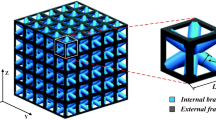Abstract
Topology optimization (TO) is a shape optimization method based on finite element (FE) analysis, and has recently been used in lightweight design on the basis of the rapid advances of additive manufacturing (AM). While the conventional TO has been applied to obtain the optimal pseudo density in a macroscale domain, microscale TO involving optimization of the strut diameters of a lattice structure has also been studied. In this study, a multiscale TO method was developed by performing the conventional macroscale TO with additional enhancement of microscale lattices. To compare the structural efficiency of the proposed multiscale TO with that of the macroscale and microscale TOs, three optimization methods were applied to a meta-sandwich beam under a three-point bending load condition. Structural FE analyses were then conducted for the three optimized beams, and their deformation behaviors were compared in terms of the structural stiffness and safety. Three optimized beams were then fabricated by the photo-polymerization type AM process using an acrylic photopolymer, and bending experiments were conducted to investigate their deformation behaviors. From the results, the multiscale TO showed the highest structural stiffness and strength owing to the enhancement of microscale lattices. The energy absorption capability was also improved compared to the result of the macroscale TO. These results demonstrate that the multiscale TO is advantageous in the design of efficient lightweight structures with enhanced structural stiffness and safety compared to the conventional macroscale and microscale TO methods.












Similar content being viewed by others
Change history
26 January 2021
A Correction to this paper has been published: https://doi.org/10.1007/s40684-020-00307-2
Abbreviations
- f :
-
Structural compliance
- K :
-
Global stiffness matrix
- F :
-
Load vector
- u :
-
Displacement vector.
- ρ :
-
Pseudo density in macroscale TO
- V f :
-
Target volume fraction in macroscale TO
- E 0 :
-
Elastic modulus of solid material
- E i :
-
Elementary elastic modulus in macroscale TO
- ρ i :
-
Elementary pseudo density in macroscale TO
- N e :
-
The number of finite elements in macroscale TO
- d j :
-
Diameter of the j-th strut in microscale TO
- V j :
-
The strut volume fraction in microscale TO
- N s :
-
The number of struts in microscale TO
- d min :
-
The minimum strut diameter in microscale TO
- d max :
-
The maximum strut diameter in microscale TO
- ρ * :
-
Reduced pseudo density in multiscale TO
- d * :
-
Strut diameter in multiscale TO
- V f * :
-
Reduced target volume fraction in multiscale TO
- V r :
-
The volume of the remaining struts after integration in multiscale TO
- N r :
-
The number of remaining struts after integration in multiscale TO
- α :
-
Scale factor to consider the strut overlapping in multiscale TO
- δ max :
-
The maximum vertical displacement
- F max :
-
The maximum compressive force
References
Rozvany, G. I. N. (2001). Aims, scope, methods, history and unified terminology of computer-aided topology optimization in structural mechanics. Structural and Multidisciplinary Optimization, 21(2), 90–108.
Rozvany, G. I. (2009). A critical review of established methods of structural topology optimization. Structural and Multidisciplinary Optimization, 37(3), 217–237.
Deaton, J. D., & Grandhi, R. V. (2014). A survey of structural and multidisciplinary continuum topology optimization: post 2000. Structural and Multidisciplinary Optimization, 49(1), 1–38.
Vatanabe, S. L., Lippi, T. N., de Lima, C. R., Paulino, G. H., & Silva, E. C. (2016). Topology optimization with manufacturing constraints: A unified projection-based approach. Advances in Engineering Software, 100, 97–112.
Thormpson, M. K., Moroni, G., Vaneker, T., Fadel, G., Campbell, R. I., Gibson, I., & Martina, F. (2016). Design for additive manufacturing: trends, opportunities, considerations, and constraints. CIPR annals, 65(2), 737–760.
Rosen, D. (2014). Design for additive manufacturing: past, present, and future directions. Journal of Mechanical Design, 136(9), 090310.
Kumke, M., Watschke, H., & Vietor, T. (2016). A new methodological framework for design for additive manufacturing. Virtual and Physical Prototyping, 11(1), 3–19.
Kim, S., Kim, D. H., Kim, W., Cho, Y. T., & Fang, N. X. (2020). Additive manufacturing of functional microarchitected reactors for energy, environmental, and biological applications. International Journal of Precision Engineering and Manufacturing-Green Technology. https://doi.org/10.1007/s40684-020-00277-5).
Sigmund, O., & Maute, K. (2013). Topology optimization approaches. Structural and Multidisciplinary Optimization, 48(6), 1031–1055.
Gaynor, A. T., Meisel, N. A., Williams, C. B., & Guest, J. K. (2014). Multiple-material topology optimization of compliant mechanisms created via PolyJet three-dimensional printing. Journal of Manufacturing Science and Engineering, 136(6), 061015.
Zegard, T., & Paulino, G. H. (2016). Bridging topology optimization and additive manufacturing. Structural and Multidisciplinary Optimization, 53(1), 175–192.
Yoder, S., Morgan, S., Kinzy, C., Barnes, E., Kirka, M., Paquit, V., et al. (2018). Characterization of topology optimized Ti-6Al-4V components using electron beam powder bed fusion. Additive Manufacturing, 19, 184–196.
Mirzendehdel, A. M., Rankouhi, B., & Suresh, K. (2018). Strength-based topology optimization for anisotropic parts. Additive Manufacturing, 19, 104–113.
Park, J. H., Goo, B., & Park, K. (2019). Topology optimization and additive manufacturing of customized sports item considering orthotropic anisotropy. International Journal of Precision Engineering and Manufacturing, 20(8), 1443–1450.
Liu, J., Zheng, Y., Ma, Y., Qureshi, A., & Ahmad, R. (2020). A topology optimization method for hybrid subtractive–additive remanufacturing. International Journal of Precision Engineering and Manufacturing-Green Technology, 7(5), 939–953.
Langelaar, M. (2016). Topology optimization of 3D self-supporting structures for additive manufacturing. Additive Manufacturing, 12, 60–70.
Mass, Y., & Amir, O. (2017). Topology optimization for additive manufacturing: Accounting for overhang limitations using a virtual skeleton. Additive Manufacturing, 18, 58–73.
Hussein, A., Hao, L., Yan, C., Everson, R., & Young, P. (2013). Advanced lattice support structures for metal additive manufacturing. Journal of Materials Processing Technology, 213(7), 1019–1026.
Park, S. I., & Rosen, D. W. (2018). Homogenization of mechanical properties for material extrusion periodic lattice structures considering joint stiffening effects. Journal of Mechanical Design, 140(11), 111414.
Lim, Y. E., Park, J. H., & Park, K. (2018). Automatic design of 3D conformal lightweight structures based on a tetrahedral mesh. International Journal of Precision Engineering and Manufacturing-Green Technology, 5(4), 499–506.
Ashby, M. F. (2006). The properties of foams and lattices. Philosophical Transactions of the Royal Society A: Mathematical, Physical and Engineering Sciences, 364(1838), 15–30.
Choy, S. Y., Sun, C. N., Leong, K. F., & Wei, J. (2017). Compressive properties of functionally graded lattice structures manufactured by selective laser melting. Materials and Design, 131, 112–120.
Nguyen, C. H. P., Kim, Y., & Choi, Y. (2019). Design for additive manufacturing of functionally graded lattice structures: A design method with process induced anisotropy consideration. International Journal of Precision Engineering and Manufacturing-Green Technology. https://doi.org/10.1007/s40684-019-00173-7.
Park, J. H., & Park, K. (2020). Compressive behavior of soft lattice structures and their application to functional compliance control. Additive Manufacturing, 33, 101148.
Panesar, A., Abdi, M., Hickman, D., & Ashcroft, I. (2018). Strategies for functionally graded lattice structures derived using topology optimisation for additive manufacturing. Additive Manufacturing, 19, 81–94.
Kang, D., Park, S., Son, Y., Yeon, S., Kim, S. H., & Kim, I. (2019). Multi-lattice inner structures for high-strength and light-weight in metal selective laser melting process. Materials & Design, 175, 107786.
Zhu, Y., Zhao, J., Zhang, M., Li, X., Wang, L., & Hu, C. (2020). An improved density-based design method of additive manufacturing fabricated inhomogeneous cellular-solid structures. International Journal of Precision Engineering and Manufacturing, 21(1), 103–116.
Wang, Y., Zhang, L., Daynes, S., Zhang, H., Feih, S., & Wang, M. Y. (2018). Design of graded lattice structure with optimized mesostructures for additive manufacturing. Materials & Design, 142, 114–123.
Gao, J., Luo, Z., Li, H., & Gao, L. (2019). Topology optimization for multiscale design of porous composites with multi-domain microstructures. Computer Methods in Applied Mechanics and Engineering, 344, 451–476.
Li, Q., Xu, R., Liu, J., Liu, S., & Zhang, S. (2019). Topology optimization design of multi-scale structures with alterable microstructural length-width ratios. Composite Structures, 230, 111454.
Zhang, Y., Xiao, M., Gao, L., Gao, J., & Li, H. (2020). Multiscale topology optimization for minimizing frequency responses of cellular composites with connectable graded microstructures. Mechanical Systems and Signal Processing, 135, 106369.
Sarvestani, H. Y., Akbarzadeh, A. H., Mirbolghasemi, A., & Hermenean, K. (2018). 3D printed meta-sandwich structures: Failure mechanism, energy absorption and multi-hit capability. Materials & Design, 160, 179–193.
Chang, N. H., Song, S. E., & Park, K. (2018). Investigation on anisotropy according to printing conditions for projection type photo-polymerization 3D printing. Polymer-Korea, 42(6), 1040–1045.
C393. (2011). Standard test method for core shear properties of sandwich constructions by beam flexure, ASTM International, 2011, https://doi.org/10.1520/C0393_C0393M-16.
Acknowledgements
This work was supported by a Korea Institute of Machinery & Materials grant (Grant no.: NK224I) and a National Research Foundation of Korea (NRF) grant (Grant no.: 2019R1A2C1002799) funded by the by the Ministry of Science and ICT, Republic of Korea.
Author information
Authors and Affiliations
Corresponding author
Ethics declarations
Conflict of Interests
The authors declare that they have no conflict of interest.
Additional information
Publisher's Note
Springer Nature remains neutral with regard to jurisdictional claims in published maps and institutional affiliations.
The original online version of this article was revised: Due to an unfortunate oversight, the colour bar of fig. 7 has been given erroneously.
Rights and permissions
About this article
Cite this article
Kim, JE., Park, K. Multiscale Topology Optimization Combining Density-Based Optimization and Lattice Enhancement for Additive Manufacturing. Int. J. of Precis. Eng. and Manuf.-Green Tech. 8, 1197–1208 (2021). https://doi.org/10.1007/s40684-020-00289-1
Received:
Revised:
Accepted:
Published:
Issue Date:
DOI: https://doi.org/10.1007/s40684-020-00289-1




